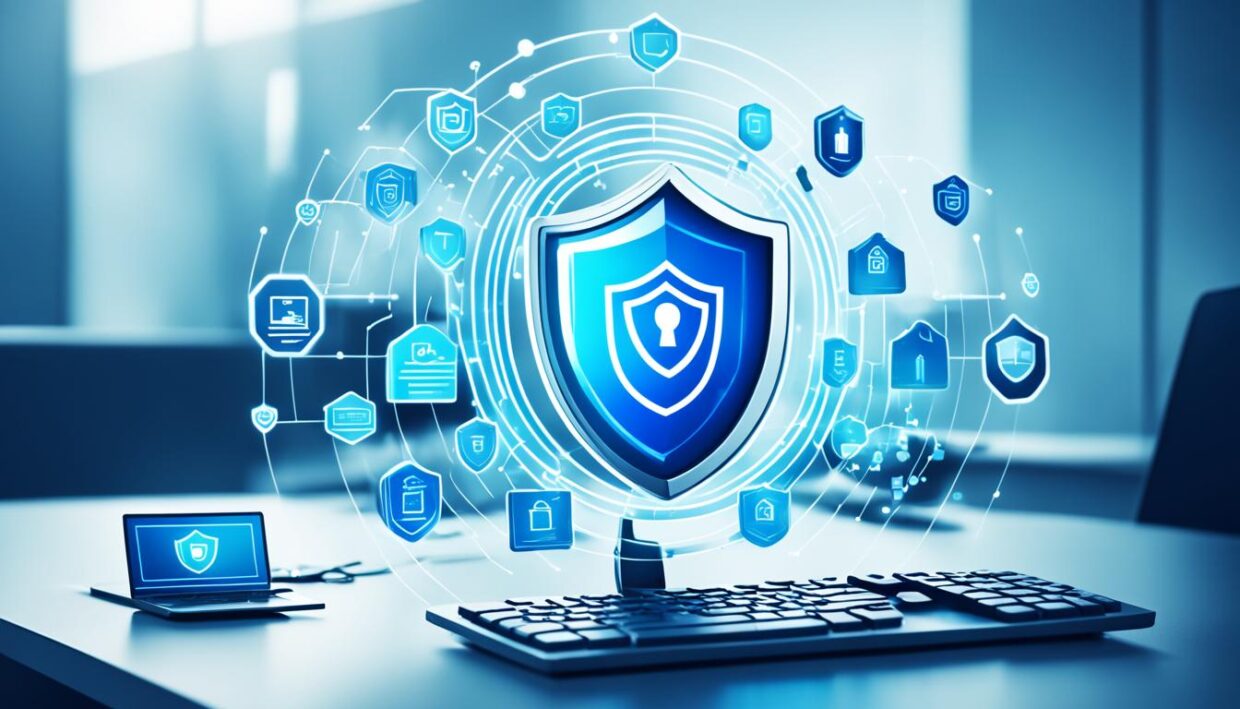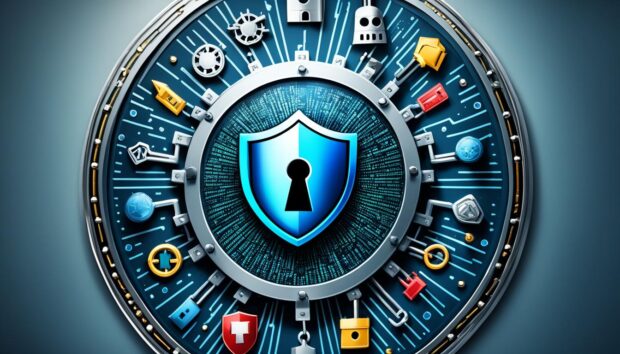
In an age where digital devices and online connectivity have become integral to our daily lives, the need for robust cyber security has never been more paramount. From the moment we wake up to the time we wind down, our digital footprint traverses a vast network of interconnected systems, each susceptible to potential misuse. In this essential guide, we’ll explore the nuances of cyber security, shedding light on its critical role in safeguarding our digital world and the strategies we can employ to fortify our online presence.
Cyber security is the discipline dedicated to protecting digital systems, networks, and data from unauthorized access or harm. It encompasses a multifaceted approach that combines technologies, methodologies, and practices to defend against a growing array of cyber threats, including malware, phishing attacks, ransomware, and more. In an age where data confidentiality, integrity, and availability are paramount, cyber security has become a fundamental pillar that supports the safety and trustworthiness of our digital civilization.
Key Takeaways
- Cyber security is crucial for safeguarding our personal information, business data, and critical infrastructure in the digital age.
- Common cyber threats include malware, phishing attacks, ransomware, DDoS attacks, insider threats, and man-in-the-middle attacks.
- Cyber security encompasses a range of technologies, processes, and practices to defend against evolving digital threats.
- Businesses face significant risks from cyber attacks, including financial losses, reputational damage, and operational disruptions.
- Implementing strong cyber security measures, such as using unique passwords, enabling multi-factor authentication, and staying vigilant, is essential for personal and organizational protection.
What is Cyber Security?
Cyber security is the discipline dedicated to safeguarding digital systems, networks, and data from unauthorized access or harm. It’s an intricate system of preventive, detective, and responsive measures against digital adversaries. At the core of cyber security lies the protection of the CIA triad – confidentiality, integrity, and availability of information.
Whether you’re sending an email, making online transactions, or streaming content, you rely on cyber security protocols to ensure the safety and trustworthiness of your digital interactions. Cyber security professionals employ a multifaceted approach, leveraging a range of technologies, processes, and best practices to mitigate the growing threat landscape.
The Evolving Cyber Threat Landscape
The cyber threat landscape is constantly evolving, with new and sophisticated attack vectors emerging daily. According to Check Point’s research, there are over 20,000 malicious mobile applications detected every day. Ransomware attacks have increased by nearly 150% in the last year, with the FBI reporting that ransom payments have reached over $400 million in 2023.
Phishing attacks, which exploit human vulnerabilities, have a success rate of around 30%. A report by the Identity Theft Resource Center found that the number of reported supply chain attacks increased by 42% from 2022 to 2023, highlighting the need for comprehensive cyber security measures.
The Evolving Cyber Security Landscape
To combat these threats, cyber security professionals must stay vigilant and proactive. The global cyber security market is estimated to reach $248.26 billion by 2023 with a compound annual growth rate (CAGR) of 10.2%, underscoring the growing importance of this field.
Businesses that prioritize cyber security can significantly reduce their risk of data breaches and other cyber incidents. In fact, companies that provide regular cyber security training to their employees experience a 70% decrease in security incidents compared to those that do not invest in ongoing education and awareness efforts.

“Cybersecurity is not just a technology problem, it’s a business problem. It’s about protecting your most valuable assets – your data, your reputation, and your ability to operate.”
The Importance of Cyber Security
In our digital age, cyber security has become a critical component in safeguarding our personal information, business data, and national security. As we increasingly rely on technology to manage every aspect of our lives, the importance of cyber security cannot be overstated.
Cyber security plays a vital role in protecting our personal privacy. It shields us from identity theft, fraudulent transactions, and cyber stalking, ensuring that our sensitive information remains secure. In the business world, a breach in cyber security can have catastrophic consequences, leading to the leakage of valuable trade secrets, compromised customer data, and damaged reputations that can cripple a company overnight.
On a broader scale, the implications of cyber security extend to national and global security. Cyber attacks can disrupt critical infrastructure, from power grids to transportation systems, posing a significant threat to the smooth functioning of societies and economies. Safeguarding against such threats is a fundamental pillar in maintaining the safety and trustworthiness of our digital civilization.
The urgency of cyber security is further emphasized by the staggering statistics. Worldwide security spending is predicted to reach $188.1 billion in 2023 and is expected to grow to $288.5 billion by 2027, according to Gartner. Ransomware attacks have increased by 13% over the last five years, with an average cost of $1.85 million per incident, as reported by Varonis. Small businesses are particularly vulnerable, with 13% experiencing a ransomware attack in the past year and 24% reporting at least one attack ever, as per Datto.
Cyber security has become a vital component in maintaining the integrity, confidentiality, and availability of our digital resources. It is a complex and ever-evolving field that requires a multi-layered approach, from robust authentication measures to regular software updates and employee training. By prioritizing cyber security, individuals, businesses, and nations can safeguard their digital assets and ensure the continued prosperity of our interconnected world.

“Cybersecurity can minimize unexpected breaches that severely damage business reputation, and companies can retain and build brand loyalty by implementing robust cybersecurity measures.”
Types of Cyber Threats
In the ever-evolving digital landscape, cyber threats come in many forms, each posing unique challenges to individuals and organizations alike. Understanding the common types of cyber threats is the first step in building robust defenses against them.
Malware and Spyware
Malware, an umbrella term for malicious software, includes viruses, worms, and trojans that can corrupt files, spy on users, or grant hackers unauthorized access to systems. Spyware, a particular type of malware, aims to violate privacy by collecting sensitive information without the user’s knowledge or consent.
Phishing and Social Engineering
Phishing and spear-phishing attacks involve deceptive emails or messages that target individuals or organizations in an attempt to steal sensitive information, such as login credentials or financial data. These attacks often rely on social engineering techniques to manipulate victims into revealing confidential information.
Ransomware
Ransomware is a form of malware that encrypts data and holds it hostage, demanding payment for its release. Ransomware attacks have become increasingly common, causing widespread disruption and financial losses for both individuals and businesses.
DDoS Attacks
DDoS (Distributed Denial of Service) attacks overwhelm a target system, network, or service with a flood of traffic, rendering it unavailable to legitimate users. These attacks can be used as a distraction for other malicious activities or to cause significant disruptions and financial losses.
Insider Threats
Insider threats, posed by disgruntled employees or malicious insiders, can be particularly challenging to detect and mitigate. These threats can come from within an organization, with individuals using their access and knowledge to compromise systems or steal sensitive data.
Man-in-the-Middle Attacks
Man-in-the-Middle attacks intercept communication between two parties, eavesdropping or altering the exchange. These attacks can be used to gain access to confidential information or to facilitate other malicious activities.

By understanding these common cyber threats, individuals and organizations can take proactive measures to strengthen their defenses and protect their digital assets from harm.
Challenges of Cyber Security
Defending against cyber threats is not a simple game of cat and mouse; it’s a complex chess match with ever-evolving rules. Cyber threats are not static; they transform, adapt, and evolve, requiring cybersecurity experts to stay vigilant and anticipate the next move of cyber adversaries. The human element can also be unpredictable, as innocent mistakes or malicious insider actions can open the doors wide for a cyber attack.
The complexity of modern networks, with cloud systems, IoT devices, and intricate infrastructures, increases the potential points of entry for cyber attackers. Furthermore, the international nature of cyber threats, where an attacker from a different continent can target anyone, anywhere, complicates jurisdiction and response strategies. Facing these challenges head-on demands a mix of constant learning, adaptability, and global collaboration.
In 2023, the CL0P ransomware group utilized zero-day vulnerabilities to execute large-scale attacks, targeting file transfer tools and impacting hundreds or thousands of organizations at a time. The use of AI-powered generative tools has also enabled cybercriminals to create more sophisticated phishing messages and malware more rapidly.
Data breaches are increasingly resulting in costly litigation and significant fines for organizations, as evidenced by the consequences faced by Uber’s Chief Information Security Officer for attempting to hide a breach from the FTC. Even tech giants like Microsoft have encountered security incidents, such as the exposure of sensitive data due to misconfigured Azure SAS tokens and the theft of a consumer signing key.
Open-source software (OSS) also faces security risks, with cybercriminals engaging in various attack vectors, including typosquatting, brandjacking, dependency confusion, and account takeover attacks, to compromise corporate environments through OSS repositories.
| Cyber Security Challenges | Impact |
|---|---|
| Evolving Cyber Threats | Require constant vigilance and adaptability from cybersecurity experts |
| Human Errors and Insider Threats | Can open the door for cyber attacks, even in sophisticated organizations |
| Complex Networks and IoT Vulnerabilities | Increase the potential attack surface for cyber adversaries |
| International Cyber Threats | Complicate jurisdiction and response strategies |
Facing these cyber security challenges head-on is crucial, as it is estimated that by 2023, cyber security may cause USD 8 trillion in damages, making it potentially the third-largest economy globally after China and the US. The pervasive nature of cyber threats means that every IT position is now a cybersecurity position, highlighting the critical need for security awareness across all technology workers.

Cyber Security
Cyber security is the formidable shield that stands between us and the malevolent forces seeking to exploit our computer systems, networks, and treasured data. It’s a dynamic art, encompassing an array of technologies, processes, and measures, all woven together to ensure the integrity, confidentiality, and availability of our digital resources. In our digital age, businesses are increasingly reliant on technology, creating new opportunities for growth but also exposing themselves to cyberattacks.
Cybercriminals are crafty adversaries, constantly evolving their tactics to breach defenses and seize control. As they continue to innovate, we must rise to the challenge by staying ahead of the curve with the latest cyber security best practices. Businesses are increasingly relying on computer systems, strengthening the link between cyber security and information security, with a focus on preventing cyberattacks and protecting electronic devices.
Safeguarding Digital Resources
Cyber security is concerned with safeguarding devices against cyberspace attacks, while information security aims to protect the confidentiality, integrity, and availability of information. It’s noted that a decade ago, the majority of sensitive information was stored in office filing cabinets, highlighting the evolution of data storage towards digital platforms like cloud providers or laptops.
Cyber security professionals are increasingly focusing on securing electronic data from threats and breaches, including physical security measures like keycards to prevent unauthorized access. Different information systems hold varying values, emphasizing the importance of prioritizing data protection based on the threat level, vulnerability, and information value.
| Key Cybersecurity Statistics | Value |
|---|---|
| Global cybersecurity spending by 2023 | $188.3 billion |
| Global cybersecurity spending by 2026 | $260 billion |
| Average cost of a data breach in 2023 | $4.45 million |
| Average cost of a ransomware-related data breach in 2023 | $5.13 million |
| Estimated global cost of cybercrime by 2025 | $10.5 trillion |
Organizations are increasingly seeking to secure information, manage cyber risk, ensure non-repudiation, and implement proper incident response protocols. An important aspect noted is the shift in the role of InfoSec professionals towards being crucial to cybersecurity roles, aiding in understanding data evaluation and implementing IT security measures.

“The CIA triad (Confidentiality, Integrity, Availability) is integral to any good information security policy, contributing to the subset of knowledge essential for cyber security.”
Security teams are urged to continually assess critical data and protection strategies to effectively safeguard sensitive information from cyber threats and breaches. As the digital landscape evolves, cyber security remains a crucial pillar in maintaining the integrity, confidentiality, and availability of our precious digital resources.
Cyberattacks
In the ever-evolving digital landscape, cyberattacks represent intentional and malevolent acts aimed at exploiting vulnerabilities in computer systems, networks, or applications. These attacks can be driven by various motives, including data theft, service disruption, or causing harm to individuals, organizations, or governments. Cyber attackers employ diverse methods to achieve their objectives, such as brute force attacks, SQL injection, Cross-Site Scripting (XSS), Man-in-the-Middle (MitM) attacks, and zero-day exploits.
The impact of cyberattacks can be far-reaching, with recent incidents highlighting the growing threat. In January 2024, a data breach of French health insurance companies impacted 33 million French individuals. In February 2024, roughly 190 megabytes of data from a Chinese cybersecurity company were exposed online, revealing espionage efforts on the governments of the United Kingdom, India, Indonesia, and Taiwan. The African Union’s systems were also disrupted by a “massive” cyberattack in March 2024, infecting over 200 user devices and lasting for over a week.
The threat of data theft and service disruption continues to escalate, as evidenced by the April 2024 hack of El Salvador’s national cryptocurrency wallet, Chivo, which exposed over 144 GB of sensitive personal information of millions of Salvadorians. Cyber espionage efforts have also targeted government officials, with Chinese spies attempting espionage against eight members of the Canadian Parliament and one senator in May 2024.
To defend against these cyberattacks and vulnerability exploitation, organizations must maintain constant vigilance, implement proactive security measures, and respond promptly to emerging threats. The average cost of a data breach is USD 4.35 million, and ransomware attacks have commanded ransom payments as high as USD 40 million. Cybercrime is estimated to cost the world economy USD 10.5 trillion per year by 2025, underscoring the critical importance of robust cybersecurity strategies.
| Date | Cyberattack Incident | Impact |
|---|---|---|
| January 2024 | Data breach of French health insurance companies | Impacted 33 million French individuals |
| February 2024 | Exposure of data from Chinese cybersecurity company | Revealed espionage efforts on governments of the UK, India, Indonesia, and Taiwan |
| March 2024 | Cyberattack on African Union’s systems | Infected over 200 user devices and lasted for over a week |
| April 2024 | Hack of El Salvador’s national cryptocurrency wallet, Chivo | Exposed over 144 GB of sensitive personal information of millions of Salvadorians |
| May 2024 | Chinese spies targeted Canadian government officials | Attempted espionage against 8 members of Parliament and 1 senator |
Defending against the evolving cyberattacks requires a comprehensive and proactive approach, combining robust security measures, threat intelligence, and a vigilant cybersecurity posture. As the digital landscape continues to transform, the need for effective cyber security solutions has never been more crucial.

Malware
Malware, a portmanteau of “malicious software,” represents a significant cybersecurity threat that can compromise computer systems, networks, and applications. This insidious family of digital invaders includes viruses, worms, trojans, ransomware, spyware, and adware, each with its unique methods of infiltration and malicious intent.
Malware Unveiled: Understanding the Culprits
Viruses, for instance, attach themselves to legitimate files and replicate when executed, silently infecting other systems. Worms, on the other hand, propagate autonomously across networks without requiring user intervention. Trojans, masquerading as benign programs, deceive users into granting them unauthorized access or compromising sensitive information.
Ransomware, a particularly pernicious form of malware, encrypts victims’ data and demands a ransom for its release, holding digital assets hostage. Spyware operates covertly, gathering information about a user’s activities without their knowledge. Adware, while less overtly malicious, inundates users with unwanted advertisements and may even surreptitiously collect personal data.
Fileless malware, a more advanced and stealthy variant, utilizes legitimate programs to infect computers without leaving behind traditional software traces, making it particularly challenging to detect and remove.
Combating the Malware Menace
- Maintain robust antivirus and anti-malware software to detect and eliminate threats.
- Regularly update operating systems, applications, and security solutions to address known vulnerabilities.
- Exercise caution when downloading files or visiting unfamiliar websites, as these can be vectors for malware infections.
- Educate users on identifying suspicious emails, links, and downloads to prevent inadvertent malware installation.
- Implement comprehensive network monitoring and breach detection measures to swiftly identify and mitigate malware intrusions.
By understanding the diverse nature of malware and adopting a multi-layered approach to cybersecurity, individuals and organizations can bolster their defenses against this ever-evolving digital menace.

Phishing and Social Engineering
In the digital age, where our lives are increasingly intertwined with technology, the threat of phishing and social engineering attacks looms large. These sophisticated tactics exploit human vulnerabilities, posing a significant risk to individuals and businesses alike.
Phishing is a deceptive technique where attackers masquerade as trustworthy entities, such as companies or authorities, to lure unsuspecting victims into providing sensitive information, like login credentials or financial details. These malicious attempts often arrive through emails, messages, or fraudulent websites designed to appear legitimate.
- Phishing attacks leverage current events, natural disasters, epidemics, and even holidays to catch people off guard.
- Vishing, a variation of phishing, exploits voice communication, while Smishing targets victims through text messages.
- Suspicious sender addresses, generic greetings, and poor grammar are common indicators of phishing attempts.
Social engineering, on the other hand, is the manipulation of individuals to gain unauthorized access to systems or sensitive information. Attackers exploit human psychology and emotions to trick users into divulging data or performing actions they shouldn’t, such as impersonating a trusted colleague or support representative.
| Phishing Tactics | Social Engineering Techniques |
|---|---|
|
|
To combat these threats, organizations and individuals must remain vigilant. Implementing robust security measures, such as multi-factor authentication, employee training, and advanced email filtering, can significantly reduce the risk of data theft and credential compromise. By staying informed and adopting proactive security practices, we can protect our digital world from the perils of phishing and social engineering attacks.

DDoS (Distributed Denial of Service) Attacks
In the realm of cybersecurity, one of the most prevalent threats is the Distributed Denial of Service (DDoS) attack. These malicious acts aim to overwhelm a target system, network, or service with a flood of traffic, rendering it unavailable to legitimate users. This causes significant service disruption and can have far-reaching financial impacts on organizations.
DDoS attacks are orchestrated by leveraging a network of compromised devices, known as a botnet, to generate an excessive amount of traffic directed at the target. This overwhelming deluge of requests can effectively shut down the victim’s resources, denying access to critical services and applications for genuine users.
Anatomy of a DDoS Attack
DDoS attacks can come in various forms, each designed to exploit specific vulnerabilities in a system or network. Some common types include:
- Amplification Attacks: Using vulnerable servers to amplify the attack traffic
- Bandwidth Saturation: Flooding the target with an excessive amount of data to consume all available bandwidth
- Cloud Resource Exploitation: Leveraging cloud infrastructure to launch large-scale DDoS attacks
- “Degradation of Service” Attacks: Subtle attacks that gradually degrade the target’s performance
These attacks can have severe consequences, causing service disruption, financial losses, and damage to an organization’s reputation. Proactive measures, such as implementing robust DDoS mitigation strategies and partnering with reliable cybersecurity providers, are essential to safeguard against these threats.
| DDoS Attack Type | Description | Example |
|---|---|---|
| Amplification Attacks | Exploits vulnerable servers to amplify the attack traffic | Smurf Attack, DNS Amplification |
| Bandwidth Saturation | Floods the target with excessive data to consume all available bandwidth | SYN Flood, UDP Flood |
| Cloud Resource Exploitation | Leverages cloud infrastructure to launch large-scale DDoS attacks | Distributed Reflective Denial of Service (DrDoS) |
| “Degradation of Service” Attacks | Subtle attacks that gradually degrade the target’s performance | HTTP Flood, Slowloris |
The threat of DDoS attacks has escalated with the availability of powerful botnets and the growing reliance on digital infrastructure. Cybersecurity experts emphasize the importance of proactive measures and robust DDoS mitigation solutions to safeguard against these disruptive and financially damaging attacks.

Data Breaches
In our digital age, data breaches have become a growing concern for both individuals and organizations. These unauthorized access incidents can lead to the exposure or theft of sensitive information, resulting in financial losses, legal liabilities, and significant damage to an entity’s reputation.
According to the IBM® Cost of a Data Breach 2023 report, the global average cost of a data breach is a staggering $4.45 million. However, the impact varies greatly, with the United States bearing the highest average cost of $9.48 million per incident – more than four times the cost in India ($2.18 million).
The consequences of a data breach can be far-reaching. Lost business, revenue, and customer trust can cost organizations an average of $1.30 million. The detection and containment of breaches add an additional $1.58 million to the overall price tag. Post-breach expenses, including fines, legal fees, and credit monitoring services, further contribute an average of $1.20 million.
The Anatomy of a Data Breach
Data breaches can occur due to various factors, such as weak security measures, insider threats, or successful cyberattacks. Some key insights into the data breach landscape include:
- Stolen or compromised credentials are the second most common initial attack vector, accounting for 15% of data breaches.
- Phishing is the most common data breach attack vector, responsible for 16% of incidents.
- Ransomware is involved in 24% of malicious breaches, with an average cost of $5.13 million.
- Cloud misconfigurations account for 11% of breaches, while known unpatched vulnerabilities and accidental data loss each account for 6% of breaches.
The sensitive information that can be exposed in a data breach may include personal details, financial records, intellectual property, or confidential business data. The impact of such incidents can be devastating, leading to financial losses, reputational damage, and potential legal liabilities.
| Data Breach Impact | Average Cost |
|---|---|
| Global Average | $4.45 million |
| United States | $9.48 million |
| Healthcare Sector | $10.93 million |
To mitigate the risk of data breaches, organizations and individuals must implement robust security measures, including strong password policies, multi-factor authentication, and up-to-date security tools. Proactive vigilance and a comprehensive cybersecurity strategy are essential in safeguarding sensitive data and protecting against the devastating consequences of these incidents.

Why Is Cyber Security So Important in Business?
In today’s increasingly digital landscape, cybersecurity has become a critical concern for businesses of all sizes. With sensitive data being stored and processed online, organizations are increasingly vulnerable to a wide range of cyber threats, including malware, phishing attacks, data breaches, and insider threats. The consequences of a successful cyberattack can be devastating, leading to financial losses, reputational damage, and even the loss of customer trust.
Implementing robust cybersecurity measures is essential for businesses to protect their sensitive data, maintain operational continuity, safeguard intellectual property, comply with regulatory requirements, preserve their reputation, and mitigate the risks posed by insider threats. By proactively addressing these cybersecurity challenges, businesses can ensure the long-term viability and success of their organization.
Protecting Sensitive Data
Businesses today handle vast amounts of sensitive information, including customer data, financial records, and proprietary intellectual property. Effective cybersecurity measures, such as encryption, access controls, and regular data backups, are crucial to safeguarding this valuable data from unauthorized access or theft.
Maintaining Operational Continuity
Cyberattacks can disrupt business operations, leading to service interruptions, production delays, and financial losses. Robust cybersecurity practices, including incident response planning and data redundancy, help organizations maintain operational continuity in the face of these threats.
Safeguarding Intellectual Property
Businesses often rely on their intellectual property, such as trade secrets, patents, and proprietary technologies, to maintain a competitive edge. Cybersecurity measures, including access controls and data encryption, are crucial for protecting this valuable asset from theft or unauthorized access.
Ensuring Regulatory Compliance
Many industries are subject to stringent regulations and standards related to data privacy and security. Failure to comply with these regulations can result in hefty fines, legal liabilities, and reputational damage. Effective cybersecurity practices help businesses meet these regulatory requirements and avoid costly penalties.
Preserving Reputation
A data breach or other cybersecurity incident can have a significant impact on a business’s reputation, leading to a loss of customer trust and potential damage to the brand. Investing in cybersecurity measures helps organizations protect their reputation and maintain the trust of their customers and stakeholders.
Mitigating Insider Threats
Insider threats, such as disgruntled employees or negligent contractors, can pose a significant risk to a business’s digital assets. Implementing access controls, monitoring systems, and employee training are essential for mitigating these internal threats and preventing unauthorized access or data breaches.
In conclusion, cybersecurity is a crucial component of modern business operations. By proactively addressing cybersecurity challenges, businesses can protect their sensitive data, maintain operational continuity, safeguard intellectual property, comply with regulations, preserve their reputation, and mitigate the risks posed by insider threats. Investing in robust cybersecurity measures is essential for the long-term success and resilience of any organization.

Cyber Security Tips
In our increasingly digitized world, maintaining robust cyber security is paramount. While the landscape of cyber threats may seem daunting, implementing a few essential practices can significantly enhance your digital defenses. By adopting these cyber security best practices, you can better protect your personal and professional data, mitigate the risks of cyber attacks, and navigate the online realm with greater confidence.
Strengthen Your Passwords
One of the cornerstones of cyber security is the use of strong, unique passwords. Avoid using easily guessable information like birthdays or common phrases, and instead, opt for a combination of upper and lower-case letters, numbers, and special characters. Consider using a password manager to generate and securely store your strong passwords.
Enable Multi-Factor Authentication
Adding an extra layer of security to your accounts by enabling multi-factor authentication can significantly reduce the risk of unauthorized access. This feature requires you to provide an additional form of verification, such as a one-time code sent to your mobile device, before granting access to your accounts.
Practice Cautious Online Behavior
Be vigilant when it comes to suspicious links, emails, or websites. Refrain from clicking on unfamiliar links or downloading attachments from unknown sources, as these could be vectors for malware or phishing attacks. Verify the authenticity of any communication before engaging with it.
Backup Your Data Regularly
Backing up your data regularly is a critical step in maintaining cybersecurity awareness. Whether it’s personal files, important documents, or business-critical information, having a reliable backup solution can help you quickly recover in the event of a data breach or system failure.
Stay Informed and Update Your Systems
Keeping your software and devices up-to-date is essential for maintaining cyber security. Software updates often include security patches that address known vulnerabilities, so be sure to enable automatic updates or promptly install them when available. Additionally, stay informed about the latest cyber threats and cyber security best practices to stay one step ahead of potential attackers.
By embracing these cyber security tips, you can fortify your digital defenses, protect your sensitive information, and foster a safer online experience. Remember, cyber security is a shared responsibility, and by taking proactive steps, we can all contribute to a more secure digital world.

Conclusion
The importance of cybersecurity cannot be overstated. With every click and keystroke, our digital lives hang in the balance, vulnerable to cyber threats that lurk in the shadows. Cybersecurity is the formidable shield that stands between us and the malevolent forces seeking to exploit our computer systems, networks, and treasured data. It’s a dynamic art, encompassing an array of technologies, processes, and measures, all woven together to ensure the integrity, confidentiality, and availability of our digital resources.
As we navigate the increasingly complex and interconnected digital landscape, personal cybersecurity awareness and the adoption of best practices are essential to protect our data, privacy, and digital well-being. By working together to build a more secure digital protection, we can unlock the full potential of technology while safeguarding ourselves from the ever-evolving cyber security importance threats.
The collaborative efforts of government agencies like the Cybersecurity and Infrastructure Security Agency (CSCE), private sector organizations, and global partners have been instrumental in strengthening our collective defense against cyber threats. Through the sharing of threat intelligence and the development of robust cybersecurity measures, businesses and individuals alike can fortify their digital fortresses and ensure resilience against the ever-evolving cyber landscape.




















Be the first to leave a comment